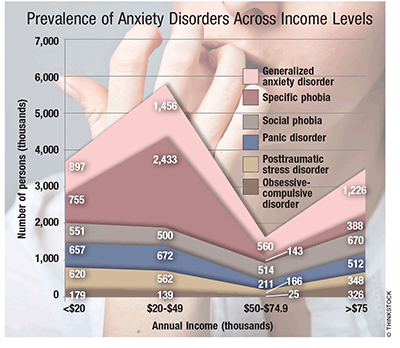US Pharm. 2015;40(1):60.
The National Institutes of Health reports that 61.5 million (1 in 4) U.S. adults have been diagnosed with a mental-health disorder. Anxiety disorders, specifically, occur in 18% of the population. Of this population, 5.4% of patients were found to have obsessive-compulsive disorder (OCD), 13.6% had posttraumatic stress disorder (PTSD), 16.4% had panic disorder (PD), 17.9% had social phobia (SP), and 33.1% had generalized anxiety disorder (GAD).

GAD: GAD was found to affect 6.8 million adults, predominantly females (74%), non-Hispanic whites (87.9%), and individuals employed full-time (62.3%). One-third of patients had a high school education, and 11.5% had not graduated from high school. In terms of marital status, 55.1%, 22.5%, and 22.4% of patients were currently married, previously married, or never married, respectively. Most patients with GAD were located in the South (33.9%) and West (31.9%).
SP: SP occurred in 15 million adults, with women and men affected almost equally (49% vs. 50.6%). SP was most likely to occur in non-Hispanic white (80%), never-married (46.6%), and full-time employed individuals (62.9%). Prevalence rates of SP in the Northeast and Midwest were similar at 15.7% and 15.4%, respectively, and were lower than rates in the West (21.5%) and South (47.4%).
PD: About 6 million adults had PD, which was more common in female (83.7%) and non-Hispanic white patients (80.8%). The prevalence was lowest among unemployed patients (9.9%), but was four times greater among individuals who were employed full-time (46.5%) or part-time (43.6%). PD was most common among patients with some college education (42.3%), followed by college graduates (24.5%) and high school graduates (20.2%). Nearly one-half of patients were currently married, 23.9% were never married, and 20.9% were previously married. The South (37.1%), West (24.4%), and Midwest (23%) were the top three geographic regions in terms of prevalence.
PTSD: PTSD, which occurred in 7.7 million adults, was more likely to affect women (58%) than men (42%). The disorder was more common among non-Hispanic whites (86.1%). PTSD occurred more often in individuals employed full-time (59.8%) than in part-timers (31.3%) or unemployed persons (8.9%). The rate of prevalence of PTSD was highest in the South (42.2%).
OCD: OCD was reported in 2.2 million adults, occurring four times more often in women (82%) than in men (18%). The prevalence of OCD was highest among non-Hispanic whites (88.6%) and those with full-time employment (57.6%). The prevalence of OCD increased linearly with the level of education attained. OCD was common among patients who were currently married (41%) or never married (45.5%).
To comment on this article, contact rdavidson@uspharmacist.com.





